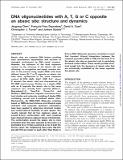DNA oligonucleotides with A, T, G or C opposite an abasic site: structure and dynamics
Author(s)
Dupradeau, François-Yves; Case, David A.; Chen, Jingyang; Stubbe, JoAnne; Turner, Christopher J.
DownloadChen-2007-DNA oligonucleotides with.pdf (4.365Mb)
PUBLISHER_CC
Publisher with Creative Commons License
Creative Commons Attribution
Terms of use
Metadata
Show full item recordAbstract
Abasic sites are common DNA lesions resulting from spontaneous depurination and excision of damaged nucleobases by DNA repair enzymes. However, the influence of the local sequence context on the structure of the abasic site and ultimately, its recognition and repair, remains elusive. In the present study, duplex DNAs with three different bases (G, C or T) opposite an abasic site have been synthesized in the same sequence context (5′-CCA AAG[subscript 6] XA[subscript 8]C CGG G-3′, where X denotes the abasic site) and characterized by 2D NMR spectroscopy. Studies on a duplex DNA with an A opposite the abasic site in the same sequence has recently been reported [Chen,J., Dupradeau,F.-Y., Case,D.A., Turner,C.J. and Stubbe,J. (2007) Nuclear magnetic resonance structural studies and molecular modeling of duplex DNA containing normal and 4′-oxidized abasic sites. Biochemistry, 46, 3096–3107]. Molecular modeling based on NMR-derived distance and dihedral angle restraints and molecular dynamics calculations have been applied to determine structural models and conformational flexibility of each duplex. The results indicate that all four duplexes adopt an overall B-form conformation with each unpaired base stacked between adjacent bases intrahelically. The conformation around the abasic site is more perturbed when the base opposite to the lesion is a pyrimidine (C or T) than a purine (G or A). In both the former cases, the neighboring base pairs (G6-C21 and A8-T19) are closer to each other than those in B-form DNA. Molecular dynamics simulations reveal that transient H-bond interactions between the unpaired pyrimidine (C20 or T20) and the base 3′ to the abasic site play an important role in perturbing the local conformation. These results provide structural insight into the dynamics of abasic sites that are intrinsically modulated by the bases opposite the abasic site.
Date issued
2007-11Department
Massachusetts Institute of Technology. Department of Biology; Massachusetts Institute of Technology. Department of Chemistry; Francis Bitter Magnet Laboratory (Massachusetts Institute of Technology)Journal
Nucleic Acids Research
Publisher
Oxford University Press (OUP)
Citation
Chen, J. et al. “DNA Oligonucleotides with A, T, G or C Opposite an Abasic Site: Structure and Dynamics.” Nucleic Acids Research 36.1 (2007): 253–262. Web. 1 June 2012.
Version: Final published version
ISSN
0305-1048
1362-4962